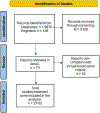Weight reduction and the impact on apnea-hypopnea index: A systematic meta-analysis
- PMID: 38908268
- PMCID: PMC11330732
- DOI: 10.1016/j.sleep.2024.06.014
Weight reduction and the impact on apnea-hypopnea index: A systematic meta-analysis
Abstract
Obstructive sleep apnea (OSA) is strongly associated with obesity. While the relationship between weight reduction and apnea-hypopnea index improvement has been documented, to our knowledge, it has not been quantified adequately. Therefore, this study aimed to quantify the relationship between weight reduction and AHI change.
Methods: A systematic literature search was performed using meta-analyses (PRISMA) guidelines for studies reporting AHI and weight loss in people with obesity/overweight and OSA between 2000 and 2023. A linear and quadratic model (weighted by treatment arm sample size) predicted percent change from baseline AHI against mean percent change from baseline weight. The quadratic term was statistically significant (P < 0.05), so the quadratic model (with 95 % prediction interval) was used.
Results: The literature search identified 27 studies/32 treatment arms: 15 using bariatric surgery and lifestyle intervention each and 2 using pharmacological interventions. Included studies were ≥3 months with weight intervention and participants had AHI ≥15/h. Weight reduction in people with OSA and obesity was associated with improvements in the severity of OSA. BMI reduction of 20 % was associated with AHI reduction of 57 %, while further weight reduction beyond 20 % in BMI was associated with a smaller effect on AHI. As the prediction intervals are relatively wide, a precise relationship could not be conclusively established.
Conclusion: The degree of AHI index improvement was associated with the magnitude of weight reduction. The model suggests that with progress in weight reduction beyond 20 %, the incremental decrease in BMI appeared to translate to a smaller additional effect on AHI.
Copyright © 2024 The Authors. Published by Elsevier B.V. All rights reserved.
Conflict of interest statement
Declaration of competing interest Atul Malhotra receives funding from the NIH. He reports income related to medical education from Zoll, Livanova, Eli Lilly and Company, and Jazz. ResMed provided a philanthropic donation to UCSD. Cory R Heilmann, Julia P. Dunn, Kushal K. Banerjee, Mathijs C. Bunck, and Josef Bednarik are employees and shareholders of Eli Lilly and Company.
Figures
References
Publication types
MeSH terms
Grants and funding
LinkOut - more resources
Full Text Sources
Medical
Research Materials



